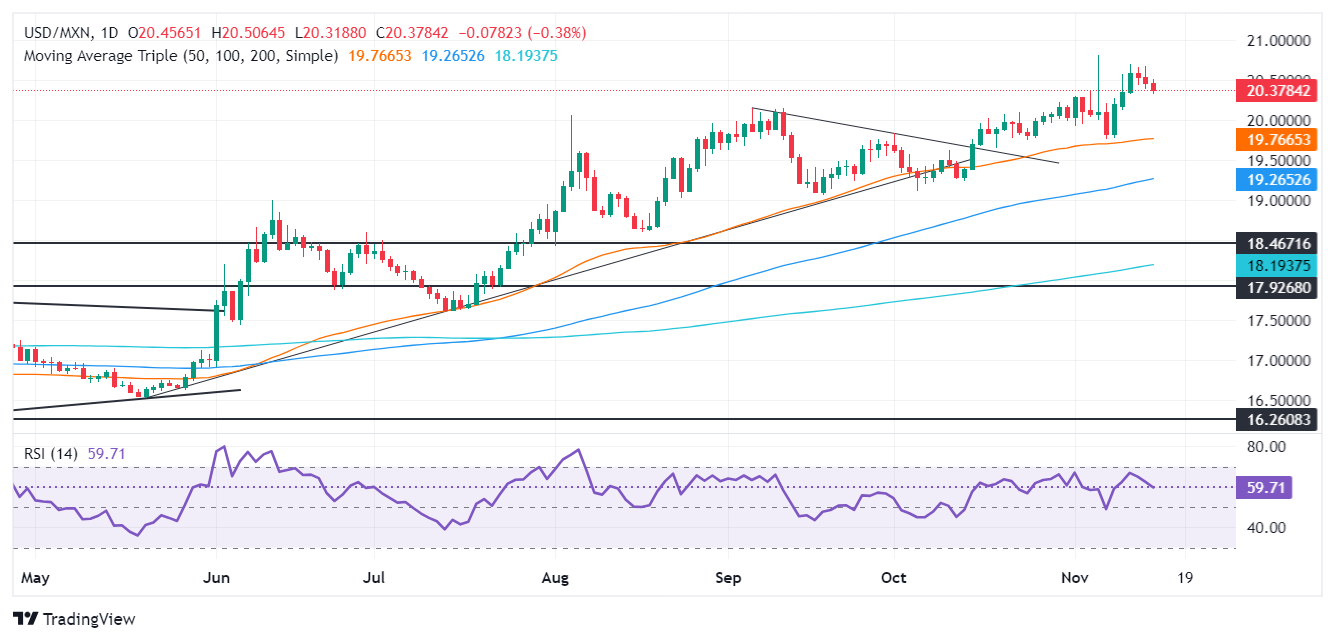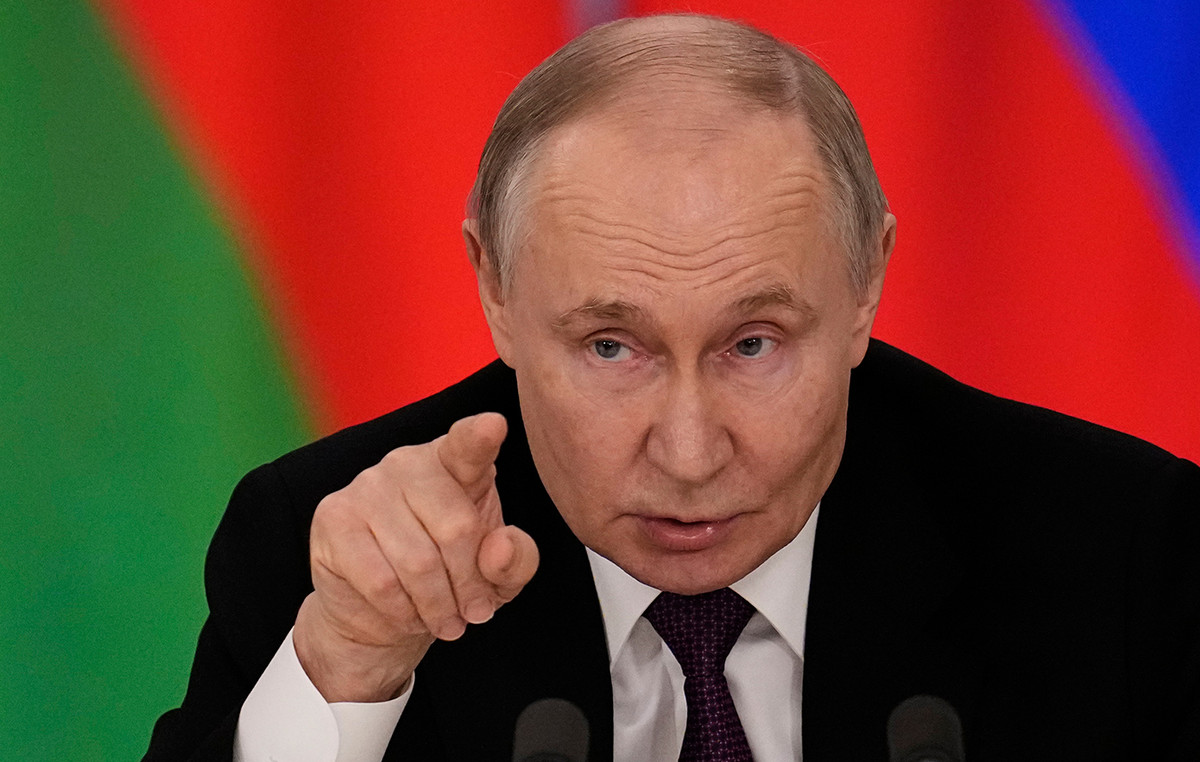- Mexican Peso Appreciates, Shrugging Negative Credit Outlook Revision and Strong US Data
- Moody’s revises Mexico’s credit outlook to negative, citing concerns about judicial changes affecting economic stability.
- Peso strengthens despite Banxico’s rate cut with inflation expectations remaining above target.
The Mexican Peso regained some ground against the US Dollar during the North American session, shrugging off Moody’s adjustment on Mexico’s credit outlook and strong US retail sales data. At the time of writing, the USD/ MXN is trading at 20.34, with a drop of 0.24%.
Due to recent constitutional changes, Moody’s Ratings changed Mexico’s credit outlook from stable to negative.
“The constitutional reform risks eroding the checks and balances of the country’s judicial system, with a potential negative impact on Mexico’s economic and fiscal strength,” Moody’s said in a statement Thursday.
Other rating agencies, such as Fitch and S&P Global, kept Mexico’s creditworthiness stable. Fitch Ratings assigns Mexico BBB-, the lowest level above speculative grade, while S&P Global Ratings has it a higher level.
Meanwhile, the Minister of Finance, Rogelio Ramírez de la O, presented the 2025 economic package in the Chamber of Deputies. Projections in the package suggest that the economy will grow between 2% and 3%, and the fiscal deficit will be 3.9% of Gross Domestic Product (GDP) by 2025.
The Peso has extended its gains to three days despite the fact that the Bank of Mexico (Banxico) decided to reduce borrowing costs to 10.25% as expected, despite recognizing that inflation risks are tilted to the upside.
Banxico expects general inflation to end 2024 at 4.7%, compared to 4.3% in previous forecasts and well above the 3% target.
Additionally, US retail sales for October, revealed by the Bureau of Labor Statistics (BLS), surpassed estimates. Other data released by the Federal Reserve (Fed) showed that October industrial production improved but remained in contraction territory.
Meanwhile, Fed officials continued to make news. The Boston Fed’s Susan Collins reiterated Fed Chair Jerome Powell’s words from Thursday that the Fed does not need to rush to cut rates. Collins said, “I don’t see a great urgency to lower rates, but I want to preserve a healthy economy.”
Daily Market Summary: Mexican Peso Strengthens on US Dollar Weakness
- A weak US Dollar undermines the USD/MXN. The US Dollar Index (DXY), which tracks the performance of the dollar against six currencies, fell 0.24% to 106.61.
- Banxico’s Governing Council voted unanimously to reduce borrowing costs from 10.50% to 10.25%, as expected. The governors added that although inflation remains high and requires restrictive policy, the disinflation process “implies that it is appropriate to reduce the level of monetary policy restriction.”
- Officials expect inflation to converge to the 3% target by the final quarter of 2025.
- US retail sales for October rose 0.4% month-on-month, beating forecasts of 0.3% but below September’s 0.8% increase. Annually, the numbers grew 2.8%, up from 2%.
- Industrial production for the same period contracted -0.3% as expected, although it improved from -0.5% in September.
- Data from the Chicago Board of Trade, via the December federal funds rate futures contract, shows that investors are estimating a 24 basis point Fed cut by the end of 2024.
USD/MXN Technical Outlook: Mexican Peso Holds as USD/MXN Falls Below 20.40
The USD/MXN bullish bias remains, although the Peso has gained some ground. For a bearish continuation, sellers must push the exchange rate below 20.00. In that case, the bears could challenge the 50-day SMA at 19.74, followed by the psychological level of 19.50.
Conversely, if USD/MXN resumes its uptrend and buyers reclaim 20.50, it will expose the current week’s peak at 20.69. Once broken, the yearly high of 20.80 emerges as the next resistance level before testing 21.00. A break of the latter and the March 8, 2022 peak at 21.46 would emerge as the next resistance.
Oscillators like the Relative Strength Index (RSI) are bullish, suggesting that further upside is projected in the USD/MXN.
The Mexican Peso FAQs
The Mexican Peso (MXN) is the most traded currency among its Latin American peers. Its value is largely determined by the performance of the Mexican economy, the policy of the country’s central bank, the amount of foreign investment in the country and even the levels of remittances sent by Mexicans living abroad, particularly in the United States. . Geopolitical trends can also affect the MXN: for example, the nearshoring process (or the decision by some companies to relocate manufacturing capacity and supply chains closer to their home countries) is also seen as a catalyst for the currency. Mexican, as the country is considered a key manufacturing center on the American continent. Another catalyst for the MXN is oil prices, as Mexico is a key exporter of the raw material.
The main objective of Mexico’s central bank, also known as Banxico, is to keep inflation at low and stable levels (at or near its target of 3%, the midpoint of a tolerance band between 2% and 4%. %). To do this, the bank establishes an appropriate level of interest rates. When inflation is too high, Banxico will try to control it by raising interest rates, which makes borrowing more expensive for households and businesses, thus cooling demand and the economy in general. Higher interest rates are generally positive for the Mexican Peso (MXN) as they lead to higher yields, making the country a more attractive place for investors. On the contrary, lower interest rates tend to weaken the MXN.
The publication of macroeconomic data is key to evaluating the state of the economy and can have an impact on the valuation of the Mexican peso (MXN). A strong Mexican economy, based on high economic growth, low unemployment and high confidence is good for the MXN. Not only does it attract more foreign investment, but it may encourage the Bank of Mexico (Banxico) to raise interest rates, particularly if this strength is accompanied by high inflation. However, if economic data is weak, the MXN is likely to depreciate.
As an emerging market currency, the Mexican Peso (MXN) tends to rise during periods of risk, or when investors perceive overall market risks to be low and are therefore eager to engage in investments that carry higher risk. . Conversely, the MXN tends to weaken in times of market turbulence or economic uncertainty, as investors tend to sell riskier assets and flee to more stable safe havens.
Source: Fx Street
I am Joshua Winder, a senior-level journalist and editor at World Stock Market. I specialize in covering news related to the stock market and economic trends. With more than 8 years of experience in this field, I have become an expert in financial reporting.








